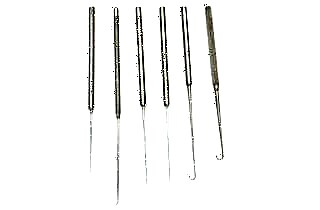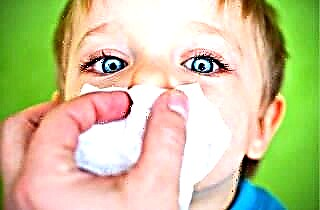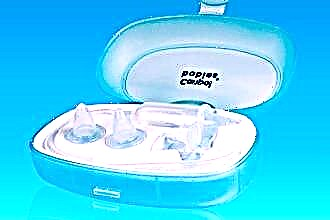Cases when, for any reason, a foreign body appears in a child's nose are not uncommon. Most often, this is due to the inattention of parents who left the baby unattended, bought him unsuitable toys or did not restrict access to small objects. It's good if you can find and retrieve the item quickly. But sometimes it penetrates too deeply and one cannot do without the help of specialists.
How does a foreign body get in
 A foreign body can get into the baby's nose in several ways. Most often, he pushes it to himself - by accident or deliberately. Thus, the nose may contain small parts of toys, seeds, beads, bones, buttons and other household trifles. Toddlers can generally do this unconsciously, and therefore it is not possible to detect the problem immediately.
A foreign body can get into the baby's nose in several ways. Most often, he pushes it to himself - by accident or deliberately. Thus, the nose may contain small parts of toys, seeds, beads, bones, buttons and other household trifles. Toddlers can generally do this unconsciously, and therefore it is not possible to detect the problem immediately.
Older children may be afraid of punishment and simply not tell their parents about it, but try to pull out the object on their own. Not understanding how to do this, they usually push him even further and in this case it is no longer possible to do without medical help. Moreover, a far-stuck object can injure the nasal mucosa and cause bleeding or purulent inflammation.
Sometimes, during medical procedures or procedures, pieces of gauze, cotton wool, etc. remain in the nose. The cotton swab can stay in the nose and when using the cotton swabs in the nasal passages at home (just jump off the swab). Such soft objects are not immediately felt in the nose, therefore, they are often detected even when inflammation has occurred.
Another common way of getting foreign bodies into the nasal cavity is with a sharp breath. So particles of dust, dirt, small insects, grains of sand, grains, etc. fly in. Although there are ants during outdoor recreation or if the basic rules of hygiene in the house are not followed, cockroaches and small bugs can crawl into the nose on their own. It is difficult to extract them at home, but it is possible.
Pieces of food sometimes fly up the nose when you cough or vomit. If they are small and not solid, then after a while they dissolve and are easily blown out. Large and hard pieces get stuck, the process of decay begins, the result of which is severe inflammation of the nasal mucosa or sinuses. In this case, you will have to treat not only the cause, but also the accompanying symptoms.
Obvious symptoms
Children who can already speak well usually tell their parents that something has gotten into their noses. Babies under 2 years old cannot do this, moreover, they often do not even realize it. Therefore, it is worth worrying if a child suddenly has the following symptoms:
 he became restless, shakes his head often;
he became restless, shakes his head often;- breathing is difficult, wheezing suddenly appeared;
- the timbre of the voice has changed, the nasal sound is heard;
- snot constantly flows from one nostril;
- blood leaks from the nose or brown crusts form;
- when touching the nose, the child complains of pain or cries;
- sleep is weak, the baby often turns and wakes up;
- appetite suddenly decreases, the child breathes heavily while eating.
More obvious symptoms appear a little later, when a foreign body provoked an active inflammatory process. They are varied and depend on the type of foreign body. The temperature may rise sharply, a purulent rhinitis, swelling of the mucous membranes may appear.
If the problem is ignored, then the inflammatory process covers an increasing area, goes to the sinuses. Sinusitis, sinusitis, frontal sinusitis, chronic rhinitis gradually develop. If the inflammation spreads to the middle ear, purulent otitis media appears, and if the bones are affected, osteomyelitis. With prolonged chronic intoxication in severe cases, there is meningitis and sepsis.
You should not try to detect and remove a foreign body from a child's nose on your own. Taking the wrong action can only make the situation worse. Therefore, the only correct way out is to immediately consult a doctor. Moreover, it often becomes necessary to conduct a thorough examination using modern equipment.
Diagnostic methods
 The easiest way to locate an object stuck in the nasal passage is to examine it from the inside with a rhinoscope. But this method only works with solid foreign bodies that have not penetrated deeply. But what if it is somewhere above the upper sky? This is where hardware diagnostics are needed.
The easiest way to locate an object stuck in the nasal passage is to examine it from the inside with a rhinoscope. But this method only works with solid foreign bodies that have not penetrated deeply. But what if it is somewhere above the upper sky? This is where hardware diagnostics are needed.
It usually begins with an X-ray. But not all objects can be seen on it. Metal and solid organic matter (seeds, seeds, etc.) are clearly visible in the picture. Less distinguishable are rubber, plastic, silicone. Small insects, grains of sand, grains, food particles are practically invisible on it. In this case, it is necessary to use computed tomography, which gives more detailed information.
In stationary conditions, the nasal passage is examined using an endoscope. It allows you to display the image from a miniature camera on a monitor, and at the end of the tube there is a special loop, which can immediately grab the object and remove it, if possible.
First aid
If a foreign body that has entered the child's nose has not caused bleeding, does not cause severe pain and does not injure the mucous membrane, then you can try to remove it yourself. But before starting any manipulations, you need to remember well what should not be done in any case:
 try to reach the object with tweezers, cotton swabs, knitting needles, matches, hooks, etc.;
try to reach the object with tweezers, cotton swabs, knitting needles, matches, hooks, etc.;- picking your baby's nose with your fingers or asking him to do it;
- rinse the nose with a stream of water (from a syringe or syringe);
- instill any drops, including vasoconstrictor;
- try to squeeze out the object by pressing on the nose along the bridge of the nose;
- give the child any food or drink before the item is removed.
What is left to do? First, wash your hands thoroughly. Then pinch the "healthy" nostril with your finger, tilt the baby's head down and ask him to exhale sharply through his nose. If there are grains of sand, grains or seeds in the nose, then this usually helps.
You can simply provoke a sneezing by slipping a pinch of black (ground!) Pepper under the baby's nose, dropping Kalanchoe juice into a free nostril, asking him to look at a light bulb or the bright sun. When sneezing, it is also advisable to close the nostril that is not blocked with your finger. If these simple techniques don't work, don't experiment further. Ask your toddler to try to breathe through his mouth so as not to pull the object even deeper, and go with him to the hospital.
Extraction methods
 Of course, you should immediately contact an otolaryngologist for help. He is familiar with the structure and features of the nose better than other specialists, and also has a whole set of tools and techniques for its examination. Keep in mind that children with foreign objects in their noses are examined out of turn!
Of course, you should immediately contact an otolaryngologist for help. He is familiar with the structure and features of the nose better than other specialists, and also has a whole set of tools and techniques for its examination. Keep in mind that children with foreign objects in their noses are examined out of turn!
After an external examination, the doctor decides whether it will be possible to remove the foreign body immediately, whether additional examination or surgery is necessary. Removing a shallowly stuck small object is carried out under local anesthesia (an anesthetic solution is poured into the nose) using a hook-loop or an endoscope. The whole manipulation takes a few minutes, the mother receives the necessary recommendations and takes the baby home.
If blood is flowing from the nose, and needles, pins and other traumatic objects are found in the picture, surgical intervention becomes inevitable.
Such an operation is performed under general anesthesia in a stationary setting, and after it for at least 1-2 days the child is under constant medical supervision.If necessary, the operation is performed immediately. But if there is no danger to the life and health of the baby, then important tests are taken before her (for blood clotting, etc.), and she herself is appointed the next day.
Care and prevention
After removing a foreign body from the child's nasal cavity, measures are required to prevent or eliminate the inflammatory process. If a purulent runny nose and other complications have already appeared, the doctor may consider it necessary to use antibacterial drugs, orally or in the form of nasal drops. In the absence of severe inflammation, it is enough to treat the nasal passages with an antiseptic solution 2-3 times a day.
 Nasal drops on a plant basis "Pinosol" have a good anti-inflammatory effect. Essential oils included in its composition have a powerful anti-inflammatory and antiseptic effect, moisturize mucous membranes well, relieve irritation and swelling. But on the recommendation of a doctor, you can use other drugs. If a foreign body has been blown out at home, it is useful for prevention to drip a nose with sea buckthorn oil.
Nasal drops on a plant basis "Pinosol" have a good anti-inflammatory effect. Essential oils included in its composition have a powerful anti-inflammatory and antiseptic effect, moisturize mucous membranes well, relieve irritation and swelling. But on the recommendation of a doctor, you can use other drugs. If a foreign body has been blown out at home, it is useful for prevention to drip a nose with sea buckthorn oil.
Of course, no one is safe from accidental hitting of small objects in the nose, especially a child. But if parents are careful and take preventive measures, then the risks can be greatly reduced:
- do not leave a child under 2 years of age playing unattended;
- remove sharp and very small objects in places inaccessible to the baby;
- do not let your child eat on the go and while playing;
- teach him not to talk and even more so laugh while eating;
- explain to your baby that it is important to chew food thoroughly;
- buy only toys appropriate for the child's age;
- inspect those toys that are already there for small and dangerous parts.
Talk to your child about the importance of telling parents about any troubles. He should know that if he makes a mistake, he will receive help from his parents, not punishment. The sooner the situation becomes clear and the baby is assisted, the less likely it is that various complications will appear.

 he became restless, shakes his head often;
he became restless, shakes his head often; try to reach the object with tweezers, cotton swabs, knitting needles, matches, hooks, etc.;
try to reach the object with tweezers, cotton swabs, knitting needles, matches, hooks, etc.;

